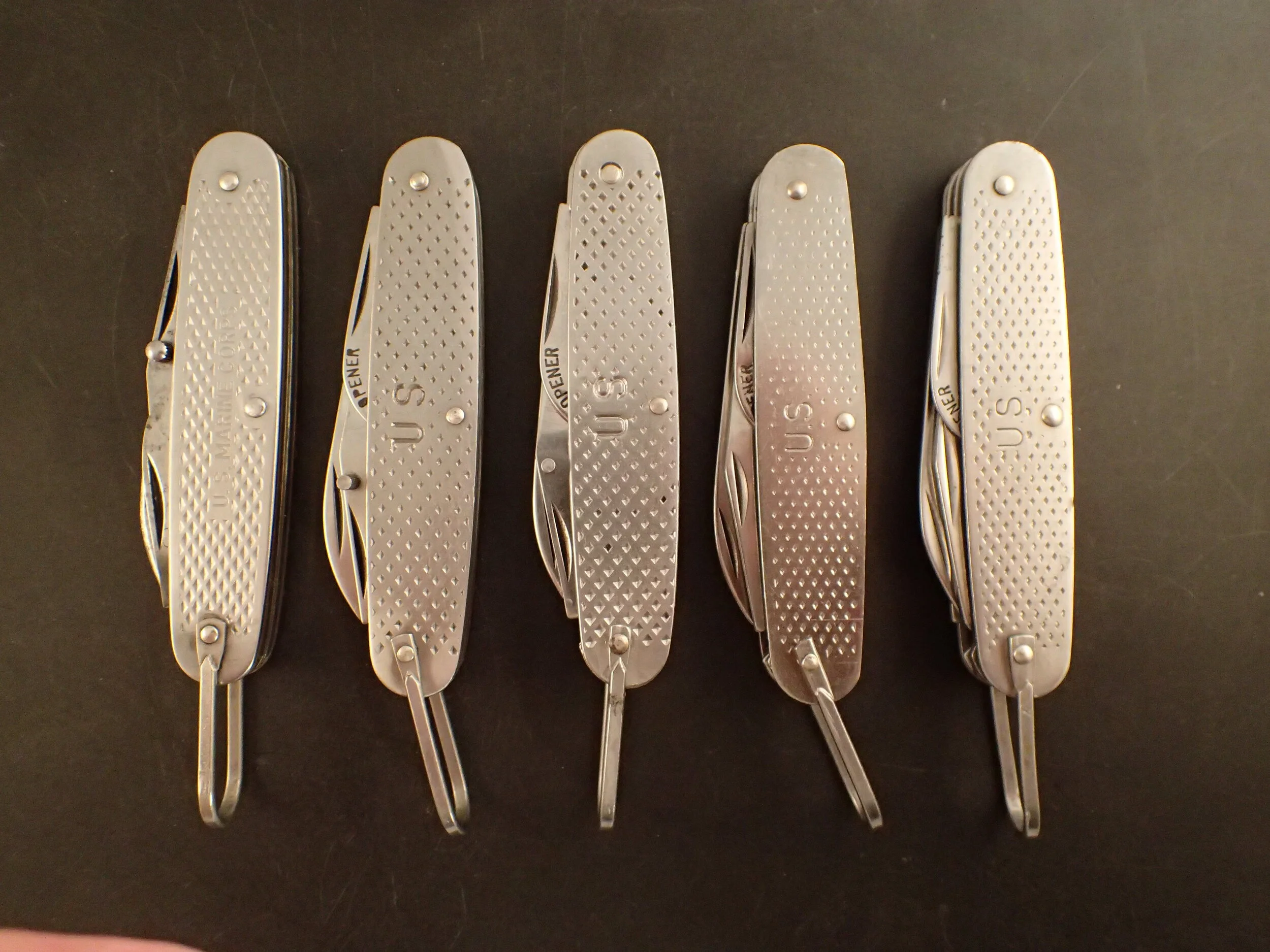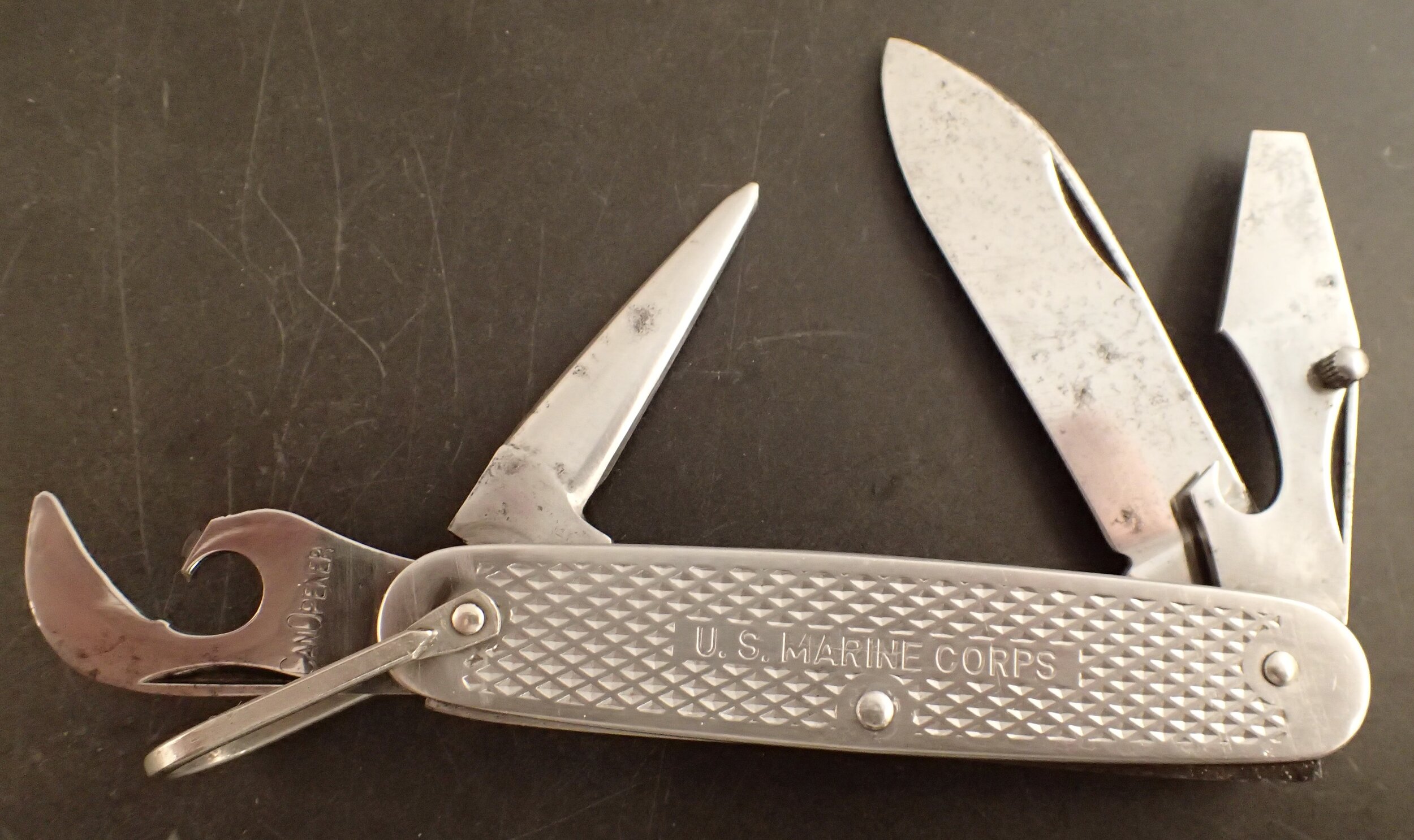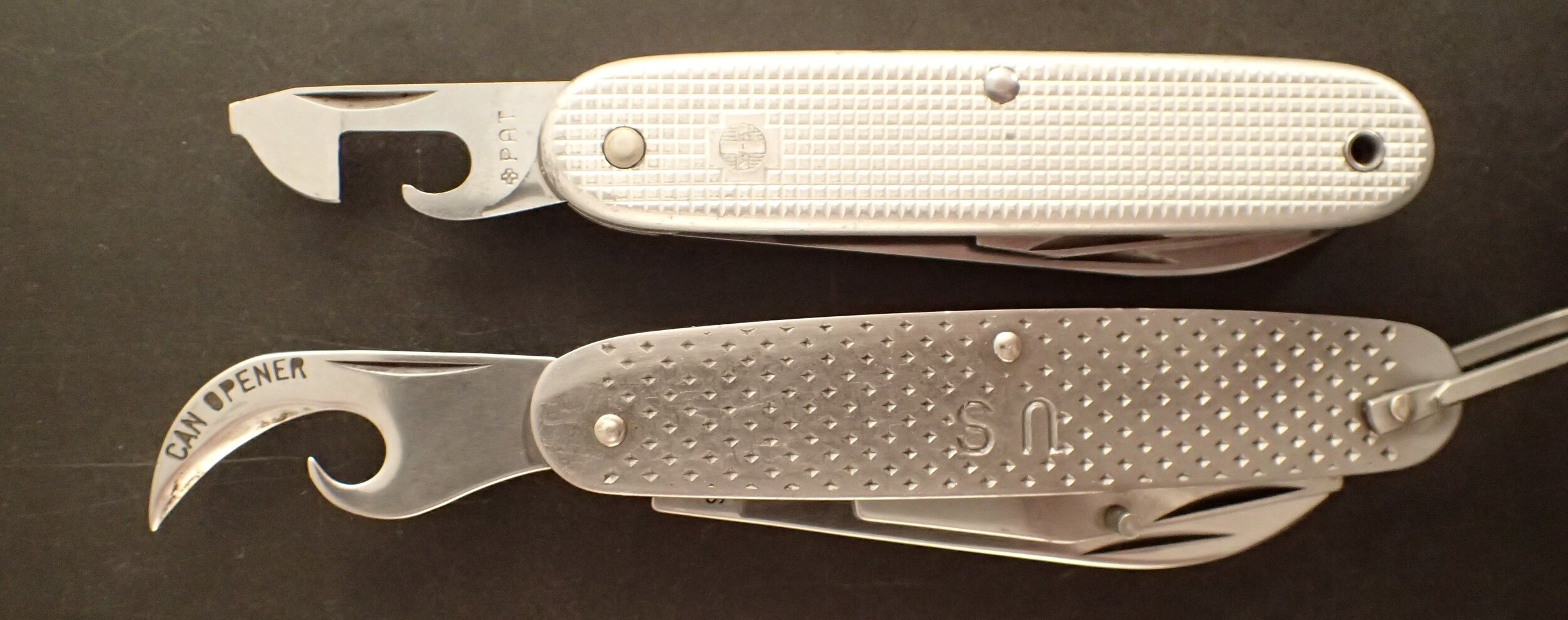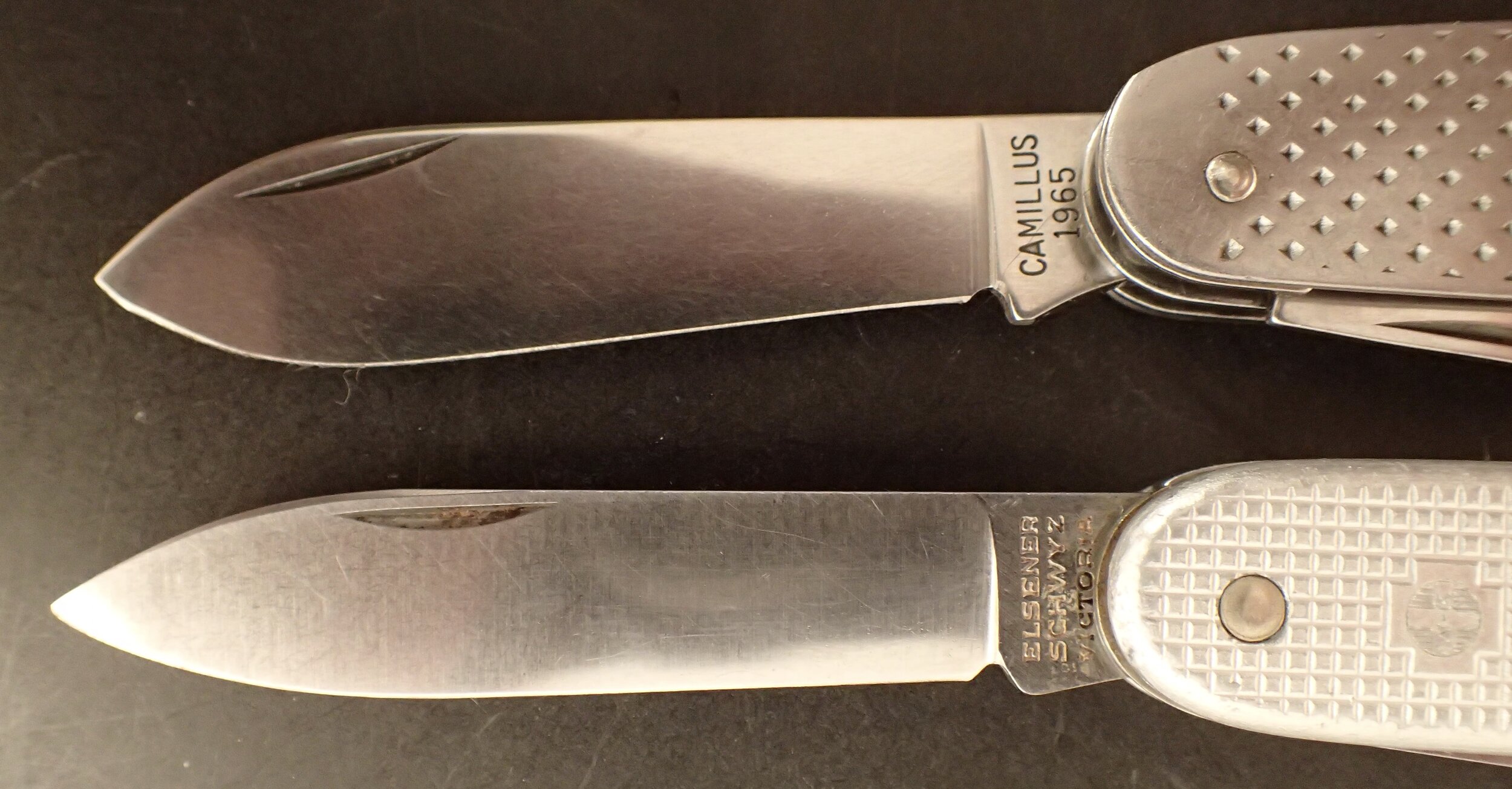Collecting the Model 1961 Soldier Knife, Part 4: the Camillus Model 1760, an American SAK.
Myron Erickson
Welcome to Part 4 of my two-part series on collecting the Victorinox Pioneer/Model 1961. Part 1 introduced the Pioneer and Model 1961, Part 2 described the six main variants of the Model 1961 and suggested a reasonable collection strategy, and Part 3 got a little off track and delved into the broader subject of scout pattern knives. Today we will be discussing the closest thing the US has ever produced to a military-issued SAK, the WWII-era Kingston USMC knife and its daughter knife the Camillus Model 1760. No collection of scout pattern knives should be without one or both of these fine knives. Even diehard Pioneer collectors like me have a couple floating around.
The Kingston USMC, a heavy duty scout pattern folding knife designed for the US Marines in WWII.
Knife, Pocket, Utility: the Kingston USMC.
For obvious reasons, World War II caused great need for a rugged, military grade scout/utility knife for American troops, and in 1943 two classic makers of scout pattern knives, Ulster and Imperial, formed a joint venture called Kingston for the sole purpose of making such a tool. The knife that resulted is usually referred to simply as the “Kingston,” but the Marine Corps referred to it as the “Knife, Pocket, Utility.” Setting aside the Swiss-ness that typically appeals to the Swiss army knife collector, this is an American military-issued scout pattern knife that has a place in any SAK collection.
Kingston USMC can opener. Note the stamping flash on my specimen’s can rim gripper. These were not finely finished tools.
My specimen dates to 1944 and is what is considered the early variant, meaning that the screwdriver/cap lifter implement is on the same end of the knife as the main blade. Other diagnostics that can vary include the markings (or lack thereof) on the clevis and can opener implement, and “US Marine Corps” stamping on the top scale. There are also US Army-issued knives, a “late” variant, and one other manufacturer in addition to Kingston, all adding up to at least seven unique versions that I have seen, so hardcore collectors have their work cut out for them. I’m happy to have one nice example, representing American industrial design sensibility and manufacturing strength amid my sea of Swiss-made soldier SAKs.
Kingston USMC (above). Note the brass liners and slight pitting on back springs. Not bad for a 76-year old knife.
When I first got interested in these knives I wondered about the thumb stud on the screwdriver. Why have both a lifting stud and a nail nick? The reason is because the back spring for the screwdriver was designed to be stiffer, almost locking strength, to make the screwdriver sturdier when deployed. Because of this, the implement can be difficult to open with your fingernail alone, which is a common complaint you’ll read of these knives on the popular knife forums.
Belt and suspenders. Nicely knurled lifting stud and nail nick on the Kingston USMC cap lifter/screwdriver (foreground).
The Kingston USMC knife is beautifully made, with brass liners and polished high carbon steel implements, but given that it was issued for a relatively short time, I will forego further description of the Kingston so we can discuss what it spawned. Being that it was produced and issued so close to the end of the war in 1944-45, it could be said that one of the Kingston’s greatest contributions to scout pattern knife history was serving as the fore-knife for what was to come next, the MIL-K-818.
The Kingston USMC (top) and the MIL-K-818 Camillus 1760 (bottom). Note the reverse orientation of the opener layer and the different “Can Opener” designations.
MIL-K-818: The Camillus Model 1760, an American SAK.
Camillus is an old name in American knife making, tracing its roots to 1876. During the war, they produced over 17 million knives of various type and spec for the military, more than any other knife maker. And after the war, they apparently were interested in fulfilling the new post-war military scout knife specification, MIL-K-818, and submitted what must have been the first production prototypes of the Model 1760 in 1949.
Family resemblance. Camillus made fine scout pattern knives for almost a century, sometimes for other makers such as Ulster.
At first glance, the Model 1760 appears identical to the Kingston, but look closer and you’ll see the screwdriver/cap lifter and can opener implements are reversed end to end compared to it. The same is true of the “late” variants of the Kingston, the spec having been changed mid-war to make the can-opener easier to operate, which makes perfect sense if you’re right-handed. The 1949 MIL-K-818 prototypes also had brass liners like the Kingston, but unlike the Kingston they had stainless steel implements and the year of manufacture stamped into the shank of the blade. Very few of these 1949 knives were produced; some collectors say as few as ten.
L to R: 1944 Kingston USMC, 1965 Camillus 1760, 2001 Camillus 1760.
And then for reasons unknown but no doubt having to do with governmental procurement bureaucracy and perhaps the Korean War, the Camillus 1760 did not enter serial production until 1957. Perhaps there were sufficient stocks of surplus Kingstons the military wanted to use up first, delaying any purchase orders of the new specification. I don’t think anyone really knows, but by the time the Camillus became standard issue, the brass liners had been dropped in favor of stainless steel, making it an all stainless construction. This must have been rather unique for the time, when you think of contemporaneous scout pattern knives, which typically used carbon steel for the implements and springs, and had scales of bone, wood, or stag.
Brass liners of Kingston USMC (below) were dropped for the MIL-K-818 spec (above) .
At least eight companies produced the MIL-K-818, but the undisputed king of the bunch is the Camillus Model 1760, which was in constant production through 2006. Over 12 million of these workhorse pocket tools were produced from 1957 until the end of production, a run of 49 years. But if you go back to its fore-knife, the Kingston, and count from 1943, that’s 63 years of pretty much continuous service for this classic mid-20th century scout pattern knife. Although the Swiss issued the Model 1961 for only 47 years, it’s interesting to note that its identical twin sister knife, the Pioneer, is celebrating its 63rd birthday in 2020 as well. Cue the Twilight Zone theme — if 63 were a prime number, I would begin to wonder. Dan Brown might use it as the kernel for his next best selling action-suspense-conspiracy thriller, but I would at least begin to wonder.
Living with the Camillus Model 1760.
Since the chances are good that you arrived at this article through your fondness for the Swiss Army Knife and not an iconic American Army Knife, you might have been unfamiliar with both the Kingston and Camillus. So, with the historical scout pattern knife context out of the way, please indulge me in a quick review of the Camillus’ features.
Like the Pioneer, the Camillus has high quality stainless steel implements. But unlike the Pioneer, even its liners and scales are stainless steel too, making it noticeably heavier. The only characteristic of the Camillus that really just bugs me is the irritatingly incomplete way it closes up, all pointy corners and edges.
Strange, the way the MIL-K-818 is designed with pointy corners and edges just waiting to catch your finger or wear a hole in your pocket.
The thank-you-Captain-Obvious award goes to the can opener, which is clearly identified for the user so that it won’t be mistaken for any of the other three implements. This may seem a little goofy at first, but as we’ve seen, this is a vestigial detail left over from the Kingston, and I find it kind of charming. And if you look at the knife when closed, it does make quickly identifying the can opener easier. And in the case of the Kingston where it first appeared, the Mirando can opener (sometimes called a “safety” can opener) was a new invention. After 75-100 years of side-opening scythe-style can openers on scout pattern knives, the new-fangled top-opening style must have seemed strange to most people. So, clearly identifying its purpose made sense in 1945.
“Opener” designation seems silly when opened, but is handy when the knife is closed and has historical reasoning.
Notably, the screwdriver/cap lifter implement includes a thumb stud on the same side as its nail nick. At first this seems almost like an afterthought to correct for some production glitch, but when I discovered that it was a purposeful design feature and not a retro-kludge, I could appreciate it. I will say that you definitely notice and feel the thumb stud when carrying the knife in your pocket. Regardless, the thumb stud disappeared in 1973. I don’t know if there was a corresponding change in the strength of the back spring, or if they just dropped the lifting stud without further consideration.
Thumb stud disappears and nail nick moves forward at some point.
The reamer is a bit of an odd thing. It’s a bit rounded in shape, a bit dull on its end, and not very sharp on its edge. It’s very sturdily made, more along the lines of an early 1957 Pioneer than the simpler reamer that appeared on the Model 1961 and continues to this day on the modern Pioneer. But I must also say that it’s not as effective at punching, awling, or reaming as the modern Victorinox style. It’s also interesting to note that the reamer is different on older Camillus specimens than it is on newer ones. I don’t know when this change occurred, but you can see it as you go from my 1965 to my 2001 examples.
In July of 2025 I was contacted by a veteran who had retired from the US Army as a Staff Sergeant. He was issued a Camillus Model 1760 in his role as a combat engineer, and he let me know that in their inventory system it was known as a Demolition Knife. I’d heard the Model 1760’s nickname “Demo Knife” before, but didn’t know if it was apocryphal or not. This gentleman explained that they were trained to use the reamer implement to core out holes in C4 or TNT explosive material to insert a detonation cord or blasting cap. It’s always great to hear about someone’s real-world experience!
Creased reamer on older Model 1760 (above) changes to a gentle concave shape, and nail nick is added to make opening possible.
Another immediately noticeable feature is the industrial strength bail, which Camillus actually referred to as a clevis, and when you hold one of these in your hand it’s easy to see why. The Camillus’s clevis is so heavy duty that it looks like you could actually employ it as rigging when using your trusty Land Rover to pull your friend’s stricken Jeep out of the mud. It is structurally attached to the knife at one of its pivots, making it much more integral than an early Pioneer’s bail, which is held on by weak spring tension, a little friction, and a magic spell. And of course the Model 1961 never even had a bail, opting for a hollow pivot that could be strung through with something or fitted with some sort of bail-type device by the user.
Massive clevis on the Camillus 1760.
Regarding the springs, although I myself have not experienced this, even the most casual perusal of Camillus reviews and descriptions will reveal its infamous proclivity for broken back springs. So if you’re shopping for one, examine the springs carefully to avoid disappointment. If all the implements are closed and the back springs are not flush with the edge of the scales, they are broken. And even still, a broken back spring can be hidden, so go for high resolution pictures and ask questions of your seller if it’s less than clear. When the springs are intact, the strong snap on these knives is impressive.
Year of issue/manufacture on every blade’s shank since 1957.
Ending on a fun note, the pièce de résistance of these American SAKs, and the feature that will hook the Birth Year Watch and BYSAK fans among you, has got to be the year of manufacture stamped into the shank of the blade, just like on a Model 1961 and every other military-issued SAK going back to the 1930’s at least. If you were born between 1957 and 2006, there is a birth year Camillus waiting for you (although I’ve read that 1962 is darn near impossible to find for some reason).
AAK vs SAK: Military Scout Pattern Knife Showdown.
How does the Camillus Model 1760 compare to the Victorinox Model 1961, its Swiss counterpart and perennial darling of the Rover Haven blog? Very well, it turns out. As mentioned above, the Camillus is slightly heavier and they are within 2 mm of each other in length. I prefer the design of the Victorinox’s reamer to the Camillus’s, but its longer-reach screwdriver might give it an edge over the Victorinox. At the end of the day, the function of the two is perfectly interchangeable and I’d be delighted to have either in my pocket when working around home or farther afield.
Camillus’ screwdriver (below) gives good reach, but Vx 1961’s (above) includes the ground scraper edge.
The spear point blade has a familiar shape to it, but the blade of the Camillus has a deeper belly than our old friend the Pioneer. The blades certainly seem comparable, although I’m not enough of a metallurgy nerd to even begin to compare the two stainless steel alloys used. I never really use can openers anymore, and I’m sure both of these would do a fine job. I do use the Phillips head functionality on the Pioneer’s from time to time, though, so I guess it edges out the Camillus there.
Vx 1961 (top) can opener includes a surprisingly useful Phillips Head screwdriver tip.
The overall fit and finish of the Camillus is definitely cruder than the Victorinox, and although they are no doubt more durable, the scales are much less comfortable to hold in your hand. In fact, in some circumstances I’d call them downright hazardous because they’re so much more slippery than the Model 1961’s. But I do confess to loving the Camillus’s clevis, which looks like an accessory out of Warn Winch’s original 1948 catalog.
Camillus blade has a deeper belly but the Victorinox has a longer, more graceful length.
It’s really style and personality where the polished Alpine classic outshines its American working class counterpart. Most obvious has got to be in the way the two knives open and snap back shut — what folding knife enthusiasts often call the walk and talk. The Camillus can be a chore to open, to the point that some folks fear its reputation as a nail breaker. The snap upon closing is good, but inconsistent from implement to implement and knife to knife, and the pointy end of the main blade actually sits up above the profile of the knife when closed, which just seems like poor design to me.
Streamlined profile of the Victorinox Model 1961.
In contrast, the Model 1961, like all Pioneers, has a silky smooth operation that’s neither too stiff, nor too flimsy. The finishing on the implements is so expertly done, the tolerance between an implement and its back spring so finely dialed in, that the whole operation is satisfying and frustration-free. There is nothing quite like the characteristic snap you get when closing a Pioneer. Everything perfectly weighted, everything under control. As Tom Petty said so well, it’s good to be king.
Matched pairs of Camillus 1760 and Victorinox 1961 from 1965 and 2001, respectively.
One final note in the interest of fairness. As we’ve seen, the Camillus Model 1760 descends directly from the Kingston military issue knife, which was a product of early-1940’s design paradigms, not to mention wartime pressures. As such, it’s really unfair to compare it to a post-war knife that was designed in the late-1950’s, when such “exotic” materials as aluminum were easier to get. For a really fair comparison we should test the Kingston against the Victorinox Model 1908, which was the SAK that was issued from ca. 1909 through ca. 1951, and the Camillus against the Victorinox Model 1951, which was in service from ca. 1952 to 1961. I have a feeling the results of such a comparison would be quite different, so stay tuned for a future Rover Haven article on this vital subject.
This concludes Part 4 of my two-part series on collecting the Victorinox Pioneer and Model 1961. Part 5 will highlight my Big Year of completing the set of Model 1961 SAKs and offer some tips for the collector. I welcome your comments and factual corrections for this article, and would love to hear about your favorite scout pattern knives. Thanks for reading.



















